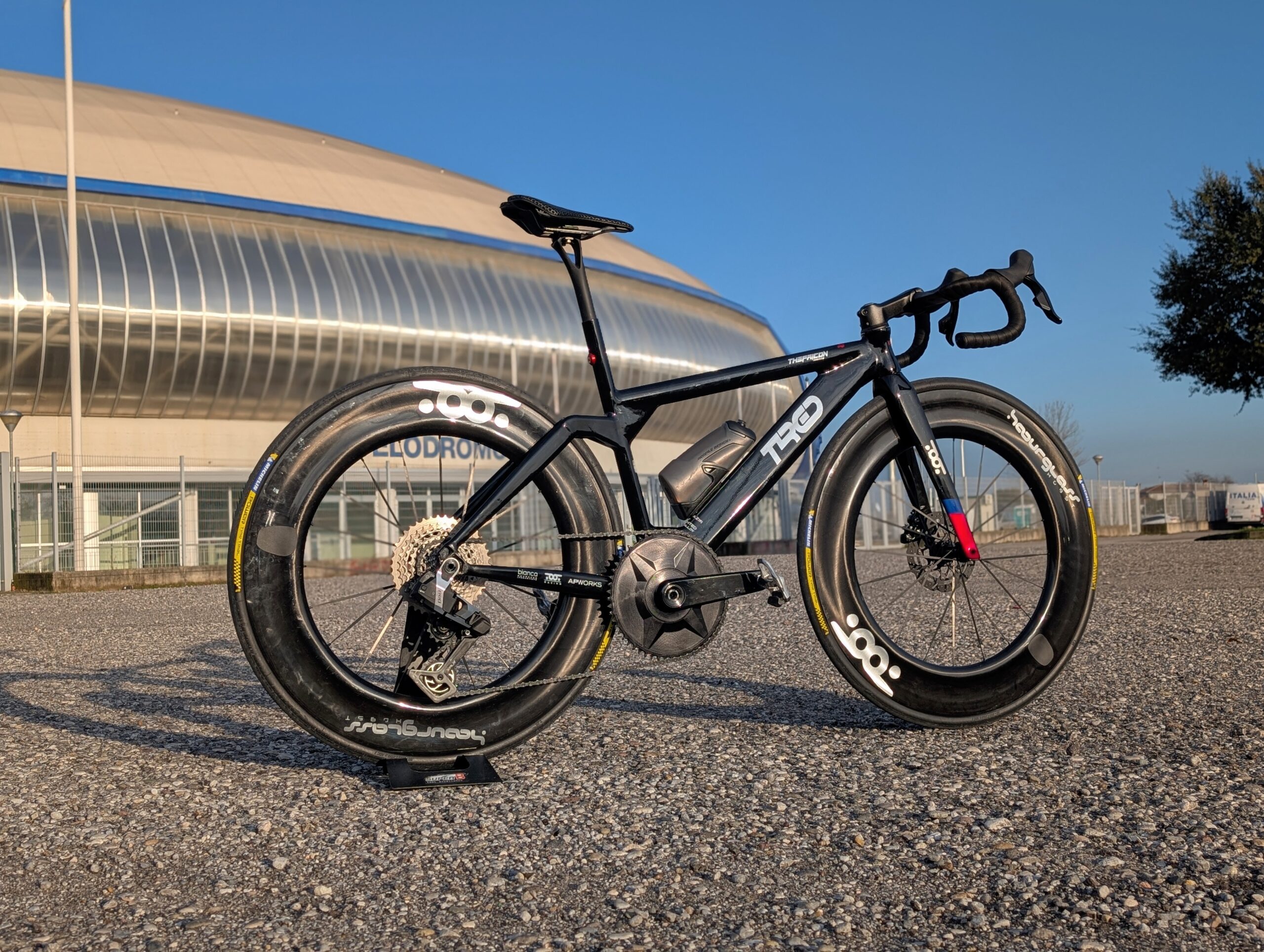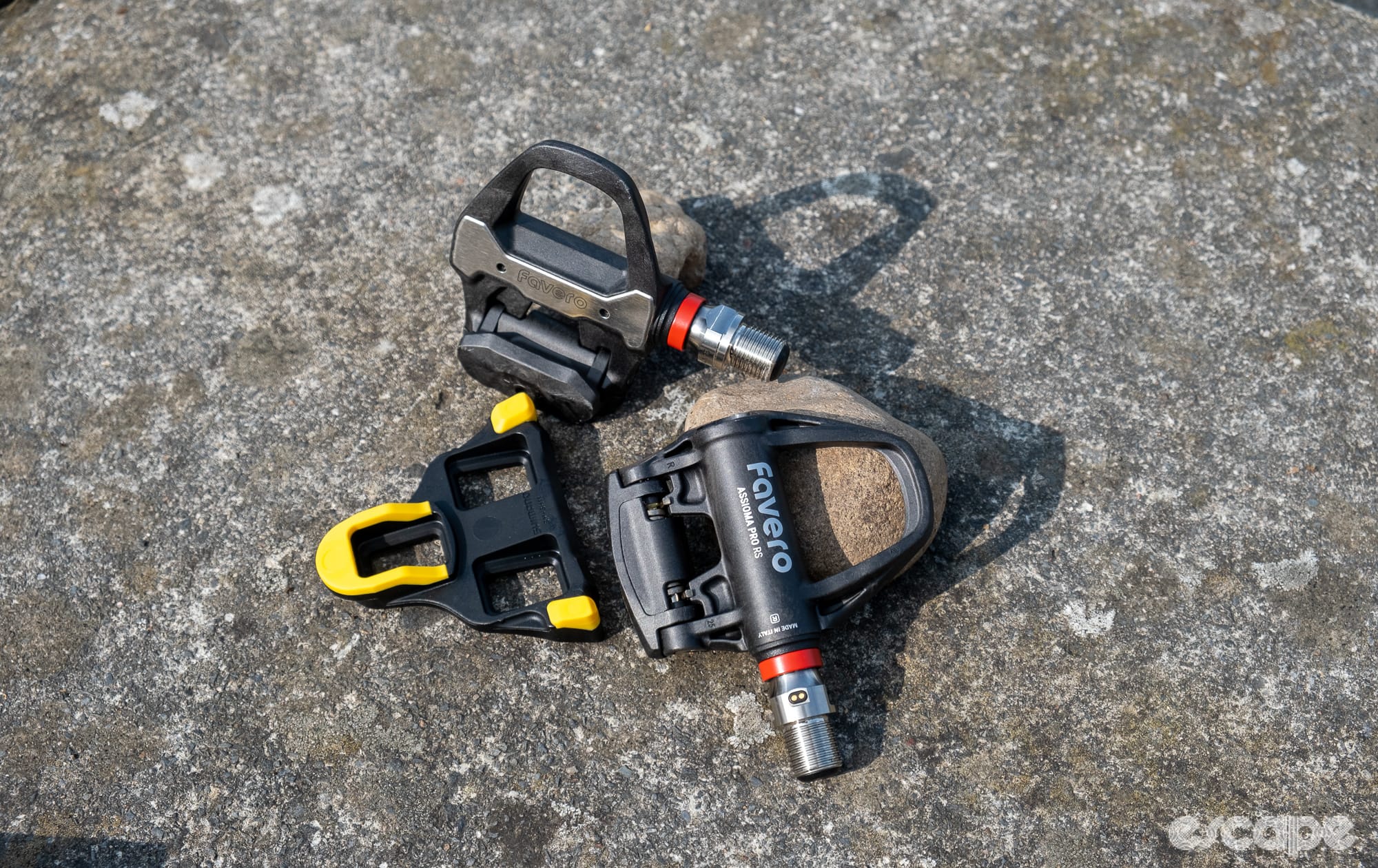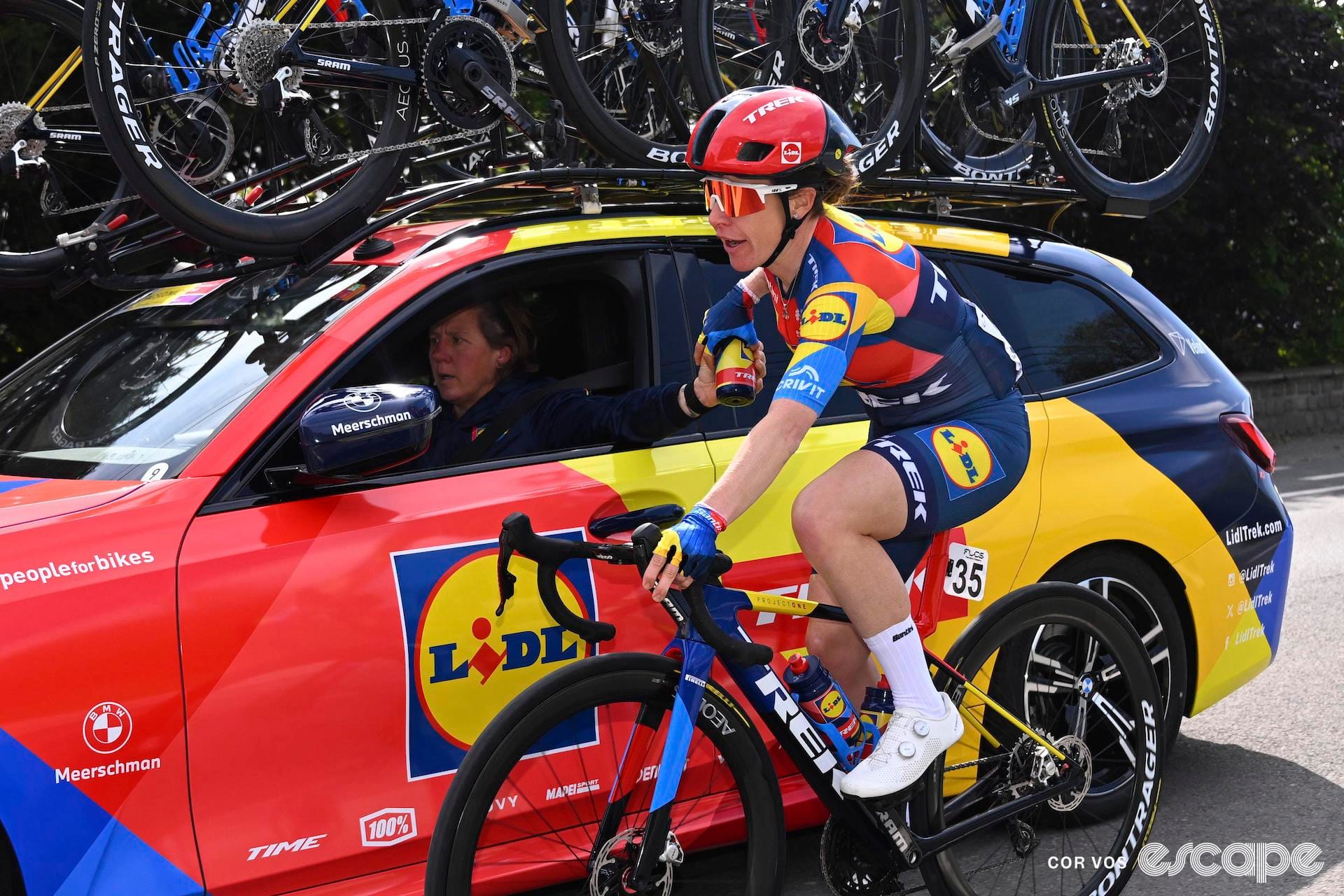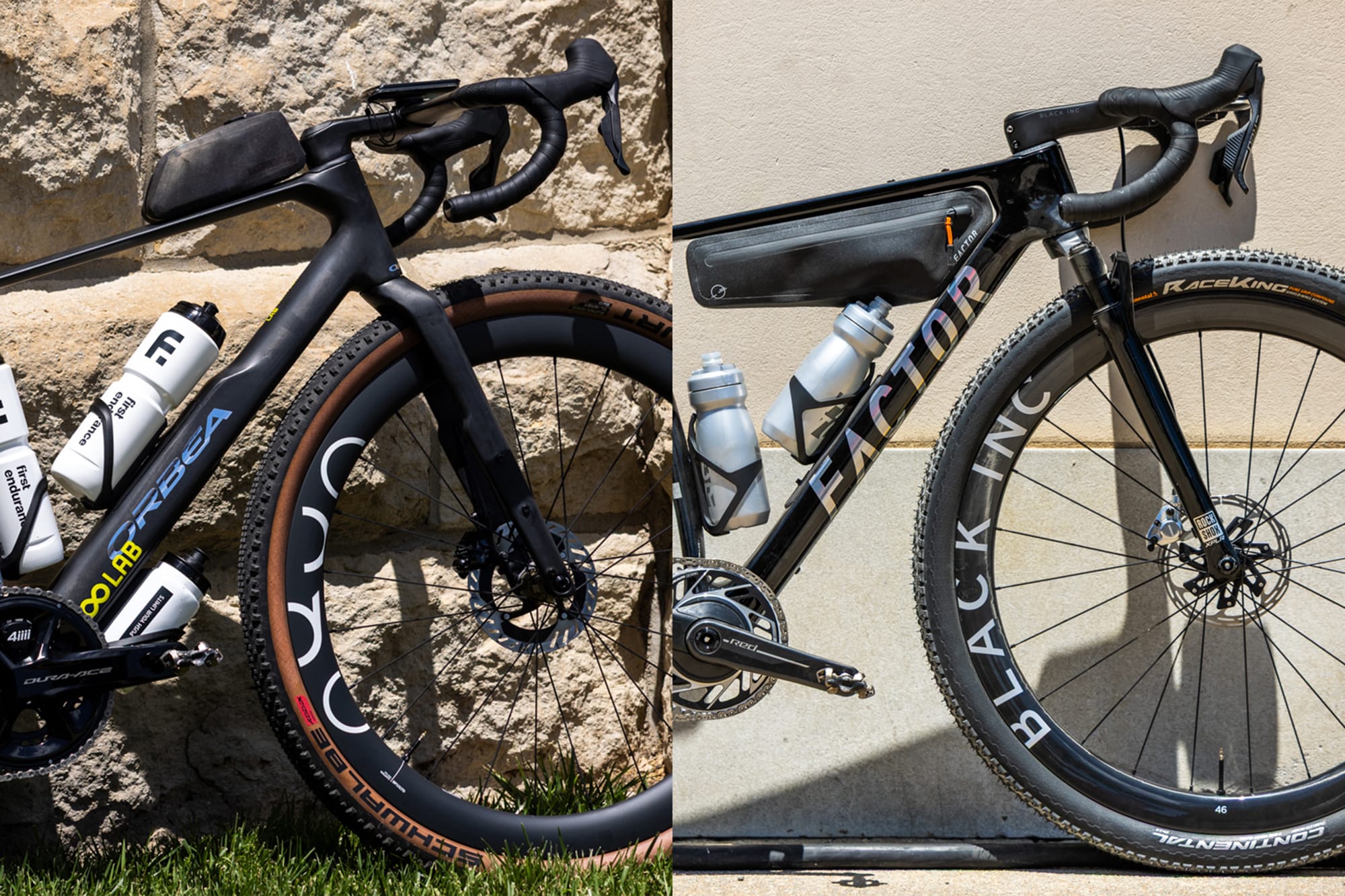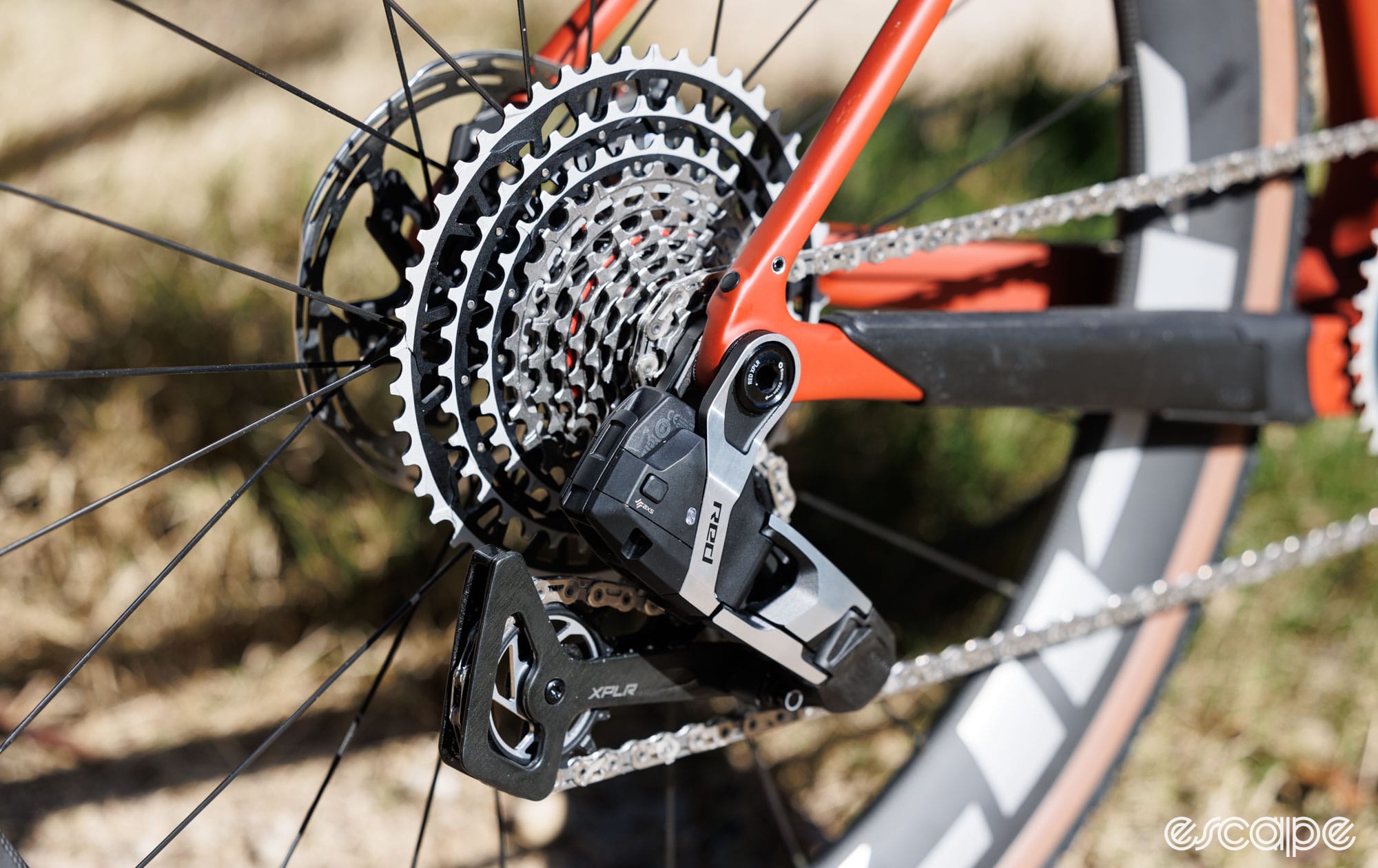Bike racing's aero disruptor Toot Engineering is making headlines again. The Italian brand claims that its new TheFalcon 300 RR road bike is more aerodynamic than its competitors’, requiring significantly less power to hold a given speed than other aero bikes on the market. Whether that's true is very much up for debate, but what is undeniable is how much of a departure it is from many other brands' approaches to saving speed.
Previously, Toot Engineering has been the centre of attention with its Ashaa RR aero bars. These looked to work within the UCI regulations governing lever position and bar width to allow the rider to adopt an incredibly aero, time trial-esque position in mass-start road racing. Jan-Willem van Schip was famously disqualified last year from Heistse Pijl, a UCI 1.1 race in Belgium, while using the Ashaa cockpit (it later transpired that the disqualification was as a result of Van Schip resting his forearms on the bars, rather than the use of the bars themselves).
Toot Engineering has not always been associated with cycling. Before 2015 the company worked across several different sectors including automotive, motorsport, aerospace, architecture, and sustainability. Since 2015 the company, along with partner brand T*Red Bikes, has steadily moved around 90% of its workload into the cycling space, first with track bikes and now with its focus also on the road.
Toot debuted its X23 Swanigami bike in 2023 at the World Track Championships in Glasgow. Toot believes this track bike is positioned as the benchmark in this space with a claimed coefficient of aerodynamic drag (CdA) of 0.188 for a rider aboard the X23 (to put this figure in context, according to aero cycling app MyWindsock the average CdA of a road racer hovers closer to 0.30). The brand has now turned its attention to the road with a design that looks different to the latest generation of aero bikes with a claimed CdA of 0.196. Per MyWindsock's numbers, on a 10-mile (16 km) flat course at an average power output of 250 watts, a difference of that magnitude could save around two minutes.
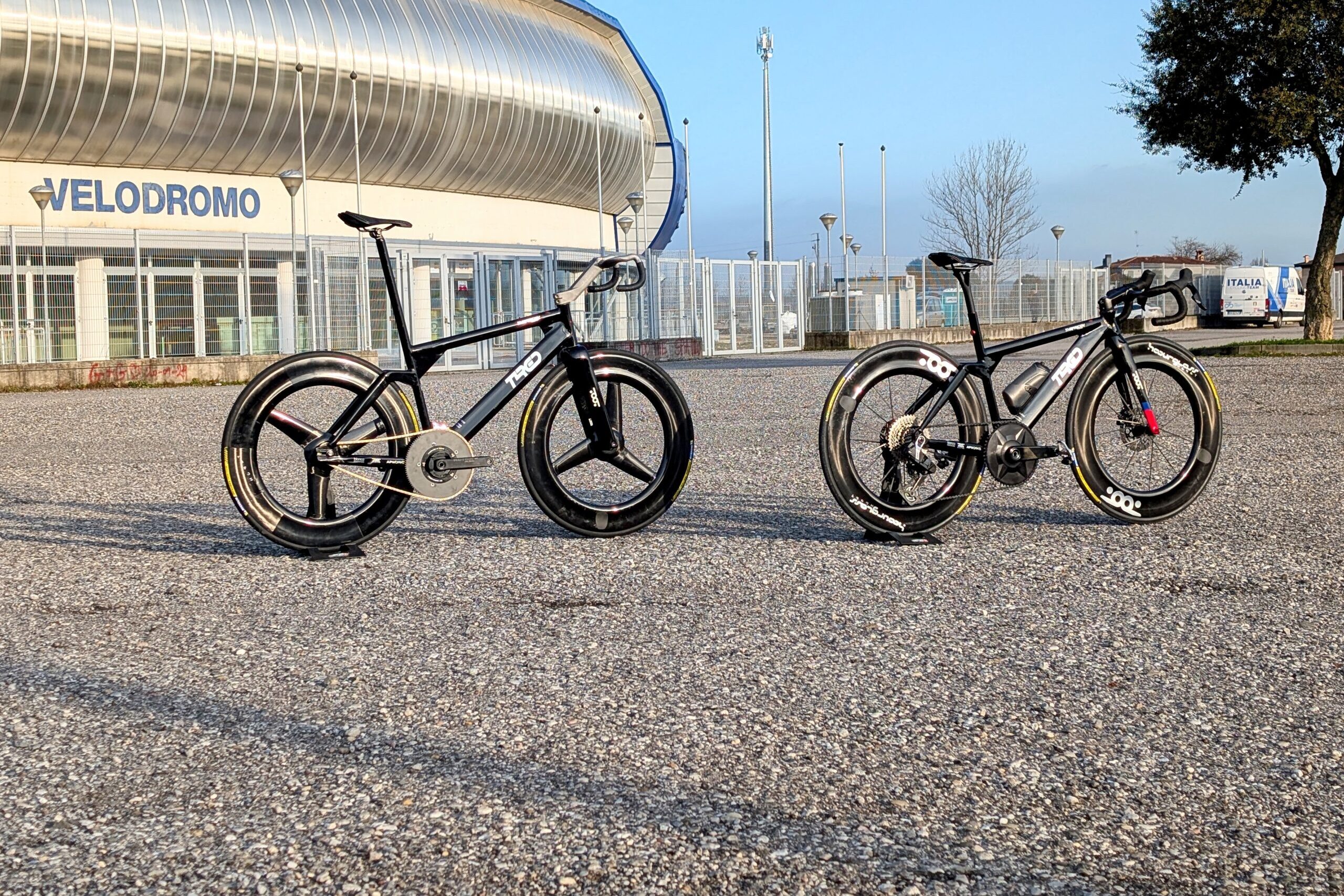
What sets the bike apart at first glance is its unique look. Smaller triangles are stronger and stiffer than larger triangles, and Toot claims this frame design is naturally more aerodynamic as the low-stack design reduces the bike's frontal area. But Toot's claims don't center only on the bike; rather the brand is focused on the bike and rider package. As you might expect with that approach, there is more to it than meets the eye. To find out more I caught up with Romolo Stanco, the brand's founder and head of design.
Track + BMX = aero road?
The new 300 RR is an evolution of Toot's TheFalcon track bike, and although it uses a different cockpit design – with the Ashaa road handlebars and with brakes, gearing and the associated hardware that these additions require – its DNA is firmly seated in the brand's track heritage.
Most strikingly, the bike features an aggressively compact frame design which sees the frame's top tube sloping down below the height of the rear wheel. This design is what Toot Engineering calls LSST (low stack, small triangles) and takes its inspiration from BMX.
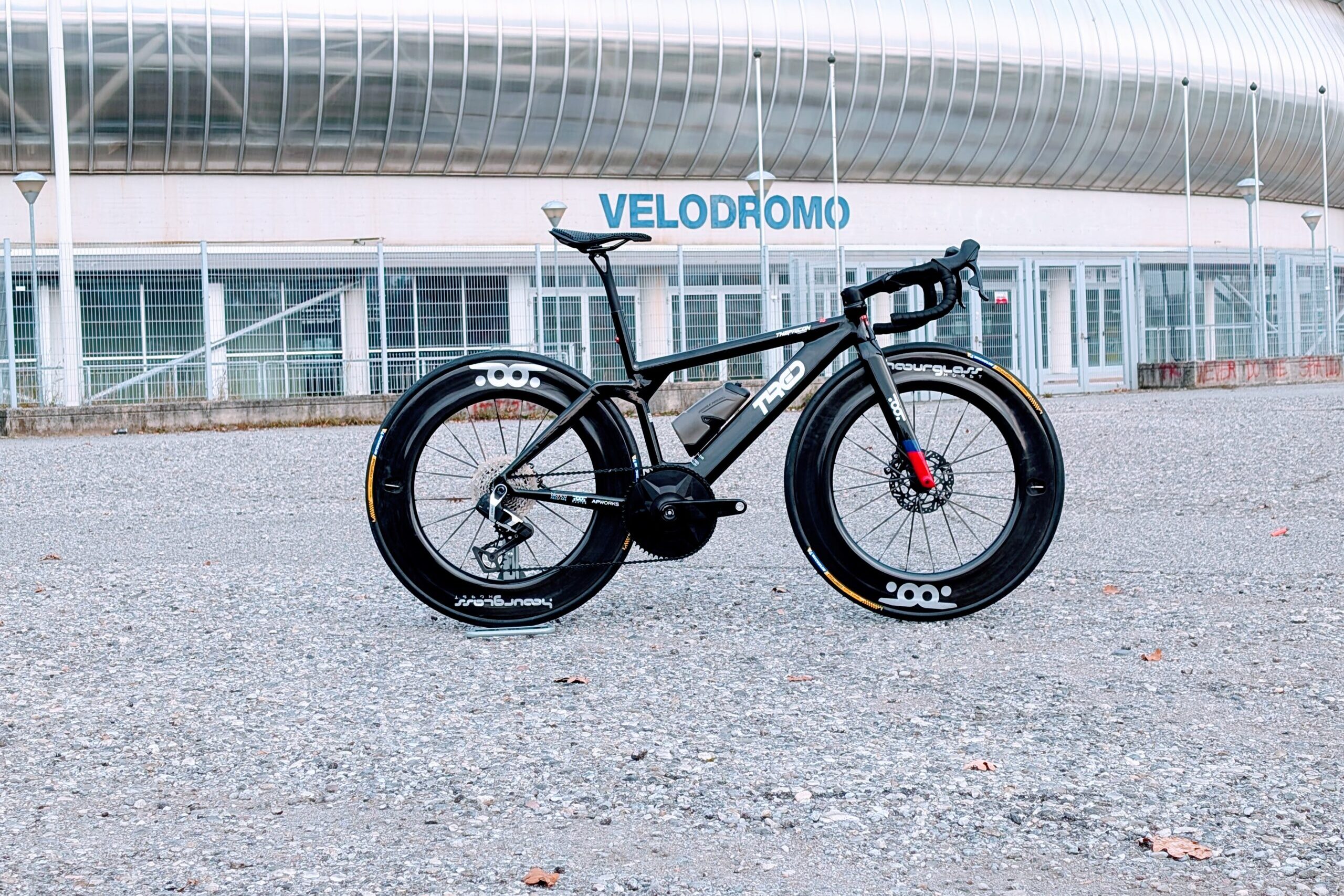
Stanco explains that's of particular benefit to taller riders. With traditional frame designs, in a larger bike, “the front triangle is not a triangle, it is a polygon. The stiffness of the polygon is not the same as a small triangle and the transmission of power is not the same because of the flexion of the frame. Engineers are using different materials, like super-stiff carbon fibre, and using a lot of material to improve the stiffness.”
By contrast, the compact frame design of TheFalcon 300 RR gives taller riders power transmission and torsional stiffness that is more associated with smaller frame sizes, without affecting the fit for the rider. It's philosophically similar to compact road frames dating back to the original Giant TCR from famed designer Mike Burrows. But Toot pushes the concept about as far as it can go.
Using a smaller frame does mean that taller riders in particular would have far more seatpost exposed, which can cause its own point of flexion. Stanco said to combat this Toot extended the seat tube above the top tube junction. This creates a seat tube length that aligns closer to a typical bike design, resulting in a similar length of seat post extended above the seat tube. Toot also uses an internal aluminium reinforcement, which Stanco claims makes the post 30% stiffer than a NACA-profiled post.
A new method of aero testing
The team at Toot developed a unique testing protocol that is at the heart of both its design ethos and claims. Instead of traditional wind tunnel analysis, it focuses on real-time data, rider comfort, and the dynamic interaction between the cyclist and the bike with the objective of optimising the rider and bike as a cohesive system. That involves some novel approaches that depart from industry standards.
Traditional wind tunnel testing is limited in its ability to replicate real-world cycling conditions. Stanco points out that wind tunnel CdA data is derived from calculations, rather than direct measurement. While CdA calculations from tunnels are widely accepted as valid and accurate (at least, within a given test run), direct measurement eliminates one possible source of error. Another benefit: Toot says its testing system includes an aero simulator to measure the effective use of power output, which conventional wind tunnels cannot.
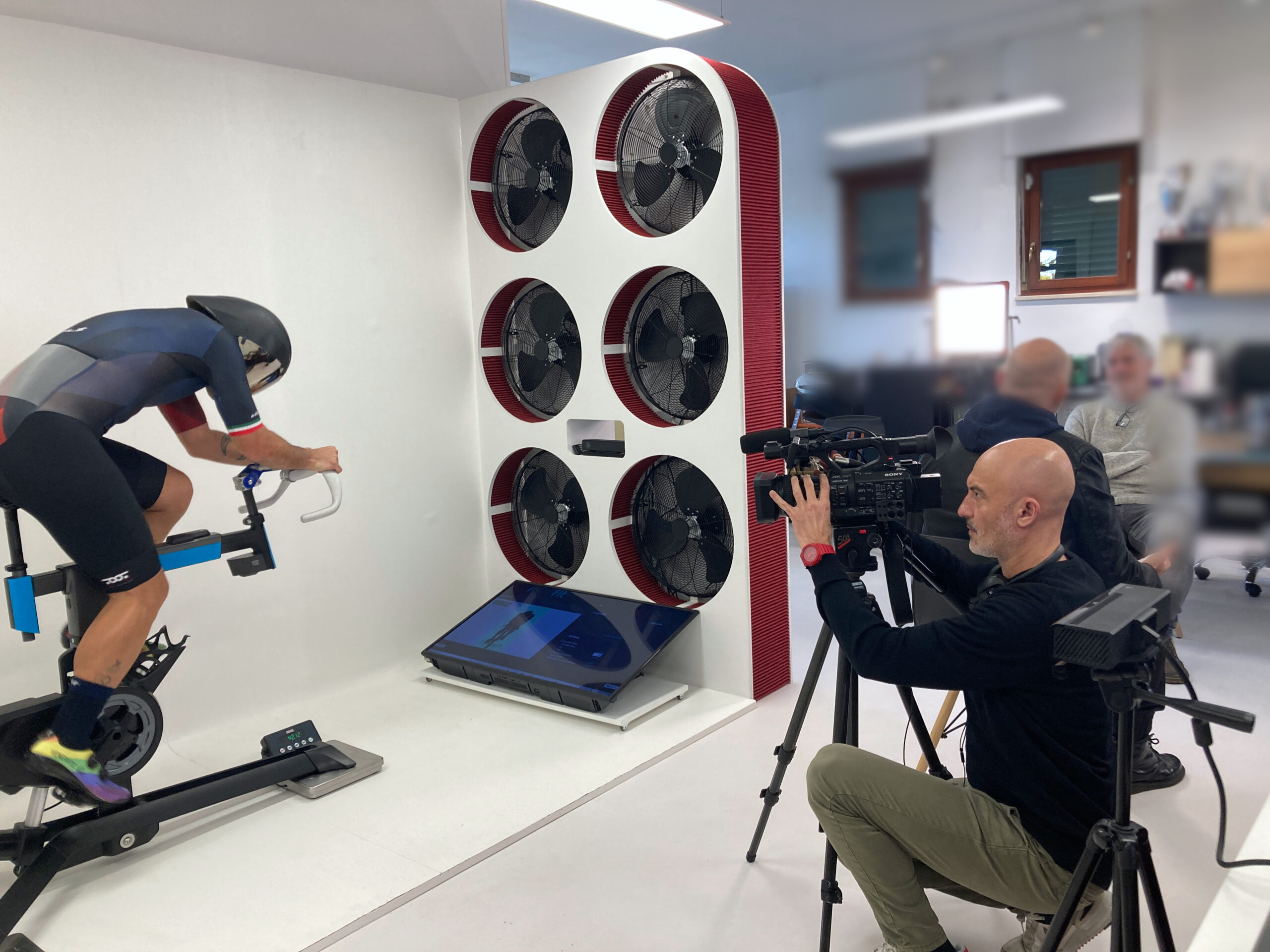
The aero simulator is designed to provide real-time CdA data based on the frontal area, allowing for dynamic analysis of the bike and the rider. Toot claims this system offers several advantages over wind tunnel testing:
- Real-time CdA: Unlike wind tunnels, the aero simulator provides direct CdA data, allowing for immediate feedback on the aerodynamic impact of changes in position or equipment, rather than requiring post-test calculations.
- Rider isolation: The simulator can isolate data from the bike and the rider, allowing it to measure only the differences from a change in position. The ability to do this allows the team to evaluate how different positions influence a rider’s performance.
- Power simulation: The simulator allows the athlete to feel the real-time power needs in relation to the CdA data. As the rider's CdA changes, the resistance of the unit will also adjust. This allows the rider to quantifiably feel the difference between positions and how much extra energy is required to maintain the same speed.
- Comfort analysis: Having a great CdA is only part of the equation – being able to produce power and hold the position are equally as critical. The real-time feedback of the aero simulator allows riders to try different positions to dial in a position that balances aerodynamics with the need to comfortably produce power.
"The setup might seem unconventional to those who are only familiar with traditional wind tunnels, but our collaboration with Japan Wind Tunnel and Fudo Aeroptim has been invaluable in refining our software settings," says Stanco. "Unlike Fudo, which lacks an active flow direction and extraction system (making the flow harder to control), we have focused on a very precise measurement volume, eliminating the aerodynamic interference of both the simulator (a Wahoo Kickr bike) and the athlete."
Stanco admits that his system is not a "real wind tunnel," but to him, that's all by intention. "Our goal was to add a wind simulator with direct wind. Our fans and the extractor allows us to have a wind speed around 50-54 km/h. There are three scales under the simulator and what is completely different than a wind tunnel is that the weight of the simulator and the weight of the athlete are eliminated by our calculations, meaning we can [isolate] the airflow on the athlete's drag."
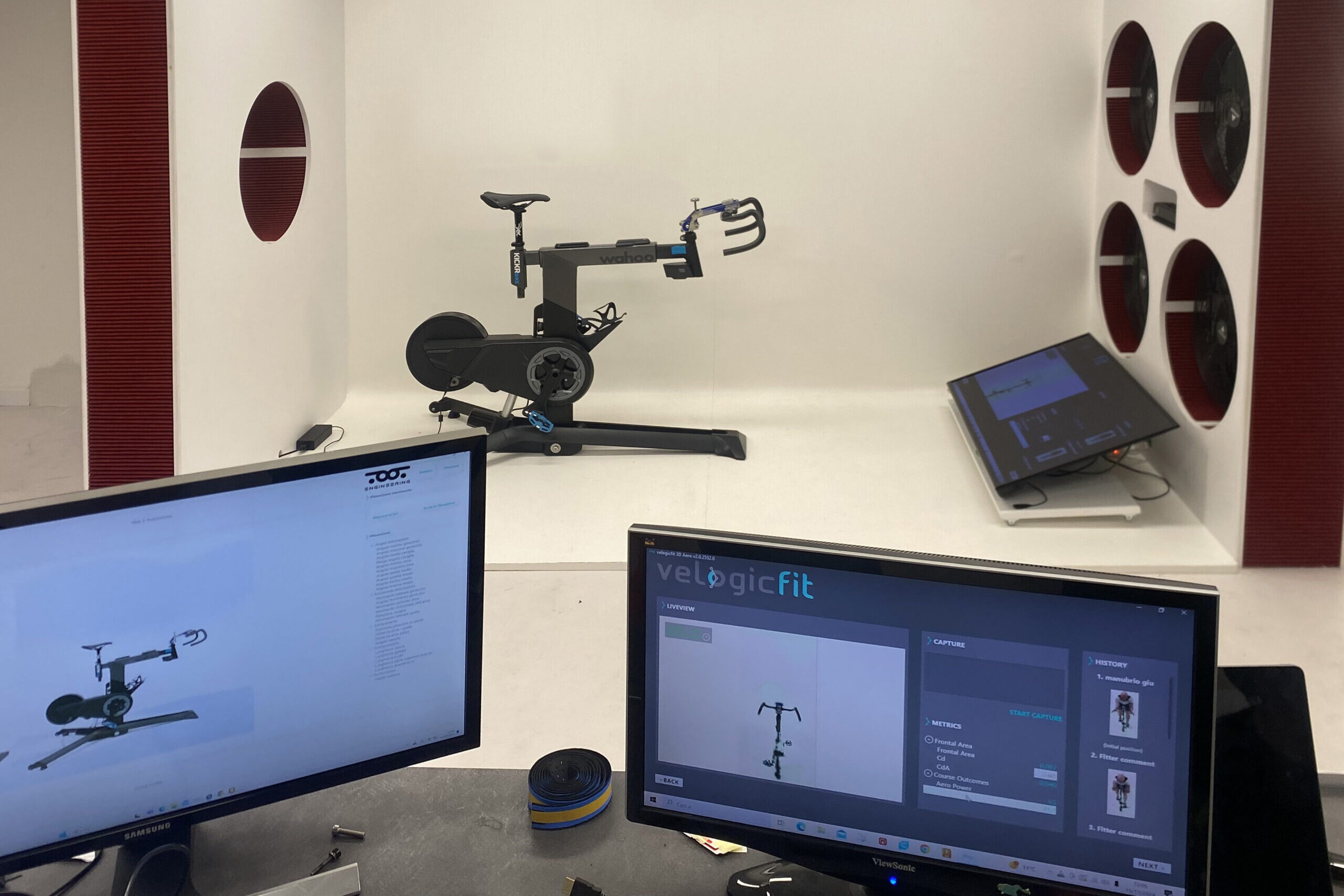
One question mark that does hang over TheFalcon 300 RR is its real world aero performance as the quoted data is solely at 0º yaw (the angle of oncoming airflow, with 0º being head-on and 90º being a pure crosswind, perpendicular to the rider), which goes against how many other brands test bikes. When pressed about the reasons for this, Stanco answers, “Testing in the wind tunnel with different yaw angles is made to understand the shapes of the rims or the fork or the frame, when the wind is not only on in front of the athlete.
“It is a step we can do when we have developed the frame or the component and we go in the wind tunnel to analyse the yaw angle on the performance of the part then we can come back to the lab and optimise the shape.” Stanco points to motorsport, where 0° yaw testing (and nothing else) is more common; he contends that testing at higher yaw angles becomes messy and the data isn't as clear.
For a track bike that will likely never see yaw past +/-5º inside a velodrome, this testing methodology makes sense. When looking at a road bike, however, higher yaw angles are commonly experienced, and true 0º yaw much more rare. Most other brands test their bikes across a +/-15º sweep to provide a wider range of data. Without this data it is difficult to understand exactly how the bike would perform outside of a velodrome.
A holistic approach to aero development
Stanco was keen to explain that the performance of TheFalcon 300 RR extends beyond simply aiming to reduce the frontal area of the bike and rider.
“Our goal is to understand how the athlete is positioned and how the components allow a reduction not only the CdA (coefficent of drag in relation to frontal area) but also the CD (coefficent of drag).” The difference, Stanco says, is the latter “is not just a matter of reducing the frontal area. To reduce the frontal area you can use a bioracer simulator or a simulator with a camera. More or less you have no more than a one millimetre error from the correct frontal area, but it's not just about frontal area, otherwise in Formula 1 everyone would go for the smallest car.”
Stanco believes that the next frontier in aerodynamic development in cycling will be in using the wind to a rider's advantage, much like in Formula 1 where car design incorporates the interaction of airflow in a holistic sense. This might lead to profiles that in isolation might not be the most aerodynamic but when viewed as a whole system offer a benefit.
On TheFalcon 300 RR, Toot engineers use tube shape, along with the stem and handlebar combination, to create a "downwash effect." This involves a low stack, a small head tube, and a specially shaped stem with a central channel for through-flow. Stanco claims this design promotes airflow under the rider's body, reducing pressure similar to a Venturi channel.
“If you compare the the shape of the X23 and TheFalcon with the shape of the Boardman Lotus 108 it is very similar," says Stanco (coincidentally the Lotus 108, like the Giant TCR, was a Mike Burrows creation). “The approach was similar but the shape design of the frame was different in the position of the athlete because (Chris) Boardman was very low. In the ‘90s the simulation was not the same as today. Now we understand that there is another opportunity and in effect we can use the airflow under the rider's body."
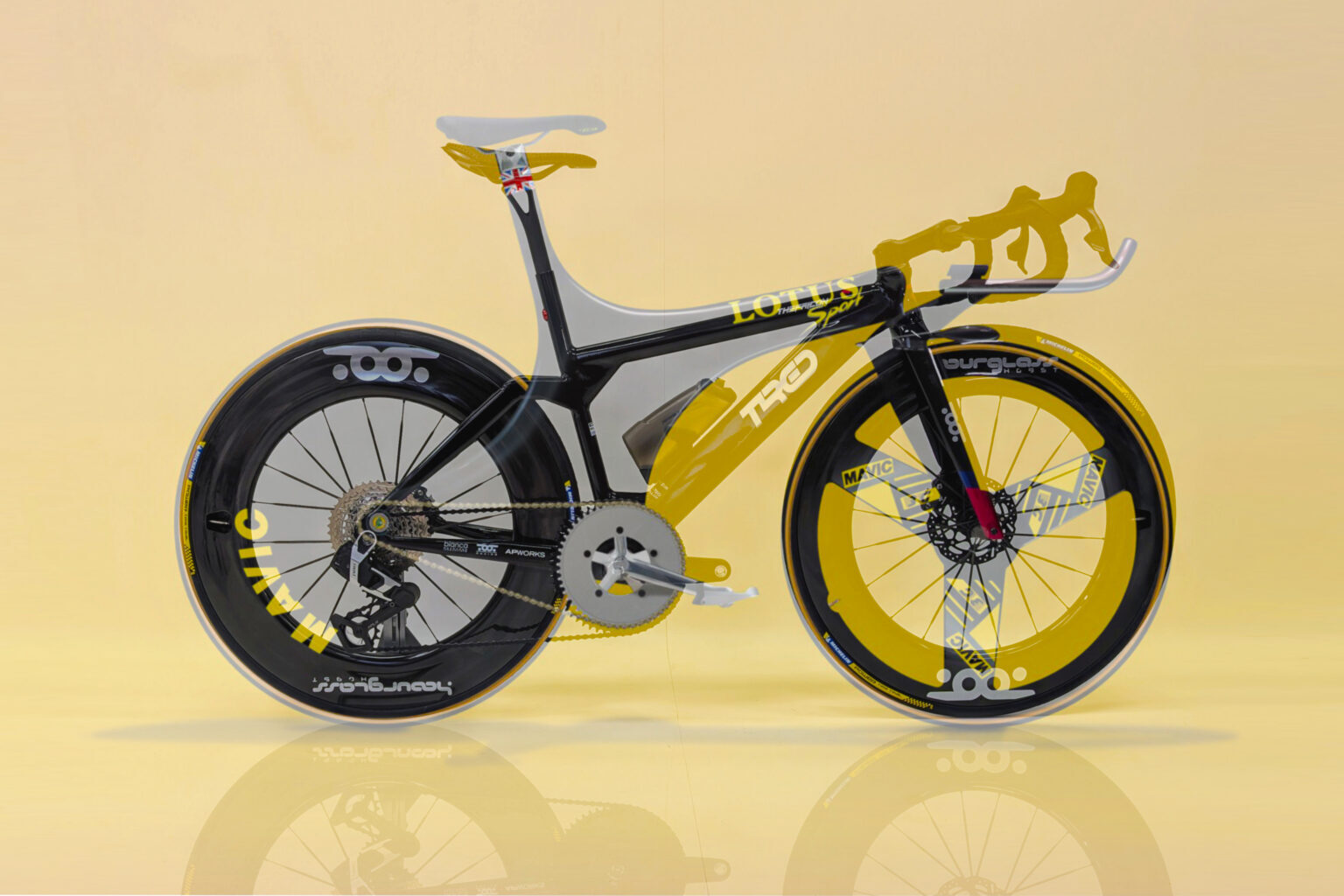
The long reach and low stack geometry purportedly helps further channel the air under the rider. Stanco explains the goal of the downwash effect is to minimise any updraft that would encourage airflow to interact with the rider’s torso.
Independent testing leaves a question mark
So is it faster? That's hard to say. Stanco says velodrome testing in Valencia, Spain, supervised by Didac Navarro (a trainer and sports scientist with UAE Team Emirates-XRG) and using former Burgos-BH pro Sebastian Mora as the test rider, showed TheFalcon 300 RR required 361 watts to sustain a speed of 50 km/h. This highlights the bike’s low CdA, with the figure measuring under 0.200 at 0º yaw.
Stanco cites other aero testing data to point to favorable comparisons to bikes like the Colnago Y1Rs, Cervelo's S5 and the Specialized S-Works Tarmac SL8. But that data comes from difference sources: Colnago's own tests on the Y1Rs with a 3D-printed mannequin, and tests by Cyclingnews on bikes including the Cervelo and Specialized. Both tests were conducted at different times and locations, under different protocols to each other and to Navarro's testing of TheFalcon 300 RR. While Stanco claims high confidence in the interpolated data, the comparison underlines a weak spot of aerodynamic testing and claims: there is no standardised protocol that all brands follow.
Testing a bike with one rider on it will yield a different result to the same bike and test protocol with a different rider, or even the same rider using different equipment; even differences in ambient atmospheric conditions from one day to another can make comparisons of the exact same rider, equipment, and test protocol difficult. Throw into the mix different testing speeds, yaw sweeps, and different interpretations of data, and while the pool of aero data grows, much of it cannot be directly compared with any significant degree of confidence.
Another, Toot-specific factor that will affect TheFalcon 300 RR's aero performance is that it will be offered only as a tailor-made bike. This means that, in reality, it is also difficult to put a hard and fast CdA figure on the bike as each one will put a rider in a different position based on the athlete's requirements. This approach to bike design, although good for dialling the exact fit requirements of a specific rider, makes it very hard to pinpoint any aero claims and makes like-for-like comparisons incredibly difficult to deduce.
A different vision for the future of bike design
Custom, however, is very much in line with Toot's philosophy for production, which Stanco says is common in other elite sports. "In [bike] racing it is normal to buy the same bike as any pro rider," he says. "Elsewhere this is not the case – you cannot buy the skis of [alpine skier] Sophia Goggia; the racket of [tennis pro] Jannik Sinner is not for sale." To comply with UCI rules, Toot does plan to sell TheFalcon 300 RR commercially. While the brand had no exact pricing info to share, Stanco says it will be less expensive than some stock bikes currently ridden in the WorldTour. For reference, the track version of TheFalcon 300 frameset sells for €4,990.
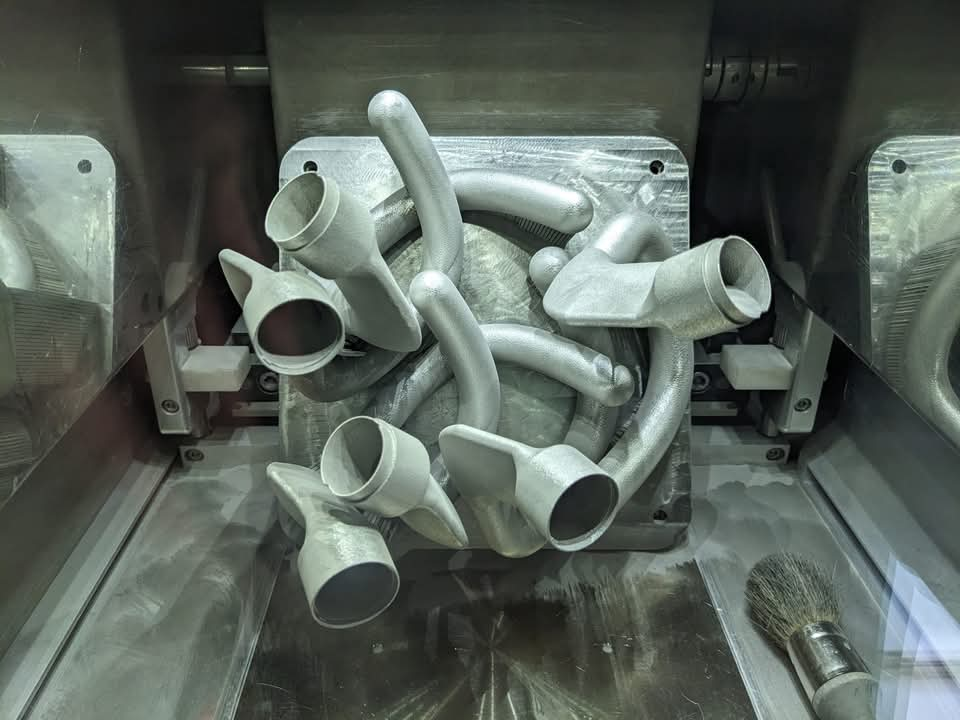
Unusually for a performance road bike, TheFalcon 300 RR is not made of carbon fibre. Rather, Toot builds the bikes by 3D printing parts in what it calls AlScaZir, an aluminum-scandium-zirconium alloy developed by the brand. “Using AlScaZir rather than carbon fibre permits us to design and build different specific features for the part," Stanco says. Carbon fibre is used for some components, such as the fork, but Stanco says that 3D printing frame parts and welding them mitigates some of the costs that composite construction would require.
“It's not a matter of building artisan bikes compared to mass production," says Stanco. "It is about using all the technologies and solutions available to design the best bicycle for each rider – different materials, a different building technology with specific tubes. We use 3D printing to customise the parts depending on who's riding it.”
So is TheFalcon 300 RR the future? Toot Engineering certainly thinks so, contending its custom-designed-and-built approach is a better way to maximise performance and comfort than trying to make stock frames fit a wide spread of riders. But it is yet to be seen how TheFalcon 300 RR stacks up in the real world against its competition, or how practical is its production process. And ultimately, aerodynamics is only part of the performance equation, with factors like ride quality and handling also key areas that can make or break a performance bike.
Toot fits a long history of disruptors in bike racing, and fresh perspectives are often what innovate the sport and move it forward. The brand's holistic design approach, which focuses not only on reducing CdA but examining how the wind might be used to the rider's advantage, may or may not yield an objectively faster bike, but other brands may find ideas to borrow for their own research and development. With races faster than ever, the need to find fresh innovations and an edge is only going to grow.
Did we do a good job with this story?

